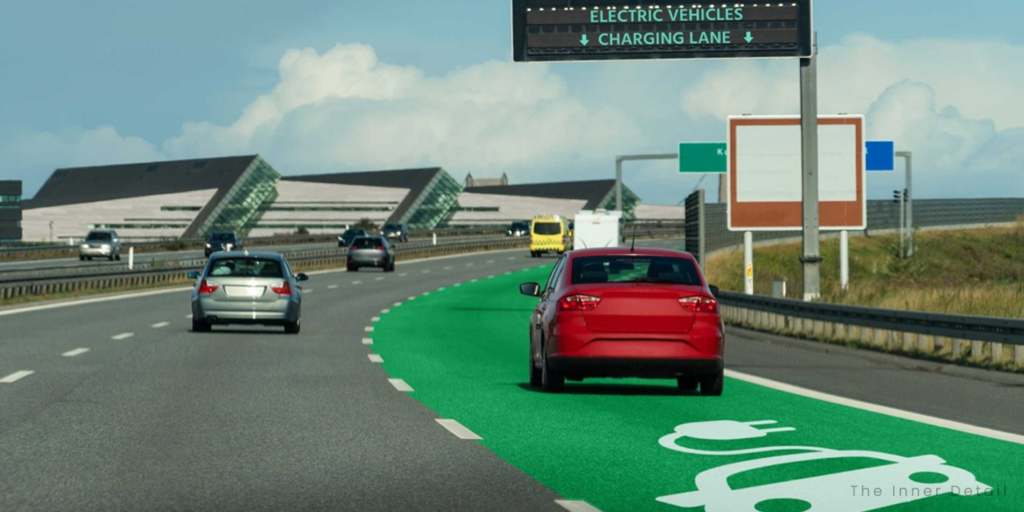A 3,000 km long fully electric road is coming in Sweden that charges EV cars, trucks and other EV vehicles while its moving, first of the kind in World.
As transportation sector is shifting for a zero-carbon emission and EU in accordance, had passed a landmark law on April 2023 insisting all new cars sold to have zero CO2 emissions from 2035. And now countries are preparing the infrastructure to support EVs for a smooth transition. Range anxiety really concerns people who drive EVs, fearing how long the battery will last while traveling on different conditions.
Addressing the issue, Sweden proposes building permanent electric roads that will charge all electric vehicles – cars, heavy trucks, and buses dynamically, as the vehicle moves on the road.
Sweden’s Permanent Electric Road
Sweden’s Transport Administration, Trafikverket has studied the ways that enables for a smooth transition of gasoline to electric vehicles, proffering all necessary infrastructure for EV owners. And finally, Sweden has commissioned for electrifying the roads, which would resolve the biggest problems of driving EVs.
“We think the electrification solution is the way forward for decarbonizing the transport sector and we are working with a number of solutions,” said Jan Pettersson, Director of Strategic Development at Trafikverket.
The country choses European route E20, that connects logistic hubs between Hallsberg and Orebro, to be electrified first. E20 is located in the middle of the country’s three major cities, Stockholm, Gothenburg and Malmö.
The Electric Road System (ERS) project is currently at the procurement stage and will be hitting roads by 2025.
How does Electric Roads work?
While there are three types of making roads electric based on its charging method, viz – catenary system, conductive (ground-based) system and inductive system, the charging method for E20 hasn’t been decided as of now.
The catenary system is where overhead lines are laid to provide electric charging to specially made bus or tram, like we see in railways. Germany installed these kinds on 2019 and is expanding them across the country. However, it could only be beneficial for heavy vehicles such as trucks, and buses.
Contrast to this, Conductive charging works good for all electric vehicles including cars. Conductive charging system deploys two tracks of rail that is laid along the road and would transfer energy from the track to a movable arm attached to the bottom of a vehicle. Not necessarily should the EV go on the track, but can glide through freely on the road; the arm is automatically disconnected and connected, whenever possible.
Sweden had already installed a 2km of electric rail in 2018, that embeds this conductive charging system in Stockholm Road linking Arlanda airport to city outside the capital.
On the other hand, inductive charging system electrifies the whole road completely by burying special equipment underneath the road which sends electricity to a coil in the vehicle. The coil in the vehicle then uses that electricity to charge the battery.
Sweden has roadways of this type too. In 2020, Trafikverket built a wireless electric road for heavy trucks and buses in the island city of Visby.
Related Posts
Pros of Electric Road System (ERS)
Electric vehicles pose an obscure challenge where the size of the battery should have to be increased if opted for a vehicle of long-range. Means, for heavy-duty vehicles, you will get trucks or buses with a huge size of batteries that they need to carry to deliver a reasonable mileage.
Static charging of vehicles likely as we now refill our tanks in gasoline vehicles at a particular station, may offshoot this hurdle of carrying huge batteries. To combat this, researchers now suggest this dynamic way of charging vehicles along the drive. With electric road system, not just heavy vehicles but also private cars could benefit of housing a comparatively small size of battery yet provide convincing mileage.
The study simulated the movement patterns of 412 privately driven cars on parts of Swedish national and European roads and found that combining home charging with dynamic charging can reduce the size of the battery by up to 70%.
Further, the study pointed out that electrifying 25% of all roads would be efficiently enough for the dynamic charging system to work, mostly implemented on urban roads. No need of electric roads everywhere.
There’s a catch, however
While ERS is planned for only urban roads, cars in rural areas might not frequently leverage from dynamic charging method, which further means, cars for rural residents require larger batteries to compensate the range. “And the difference in battery range between these two types of residents could be up to 20%”, says Dr Washim Shoman, Researcher at the Chalmers University of Technology.
Technology still maturing, and the study can be improvised to meet out such properties, says Shoman. Sweden plans to extend the ERS to about 3,000 km of roads by 2045, partnering with Germany and France for authorization and research collaborations.
In the time where countries blindly pushing people to adhere to EVs, Sweden is making a responsible shift towards zero-carbon emission approach, innovating the infrastructure to serve the best needs.
Italy, UK, United States and India are also in works of research of electrifying their roads.
Hope you find the page useful…
(For more such interesting informational, technology and innovation stuffs, keep reading The Inner Detail).

